Life of St. Dominic of Guzman
1. Childhood in Castille
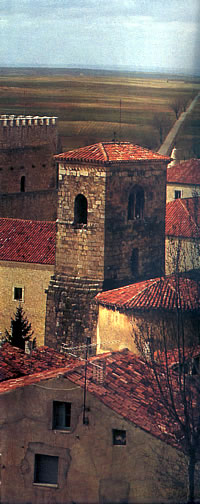
Blessed Cecilia Caesarini, who was received by St. Dominic into his new order, in her old age described him thus :
He was thin and of middle height. His face was handsome and somewhat fair. He had reddish hair and beard and beautiful eyes. From his forehead and eyes shown a sort of radiance which drew everyone to respect and love him. He was always cheerful and alert, except when he was moved to compassion at the sight of someone’s troubles. His hands were long and fine and his voice pleasingly resonant. He never got bald, though he wore the full tonsure, which was mingled with a few grey hairs.
Our knowledge of Dominic de Guzman’s life is chiefly based on the Libellus of Jordan of Saxony, his successor as head of the Order of Preachers which Dominic founded. Jordan knew Dominic personally and wrote only about twelve years after his death, but had not been one of his close companions. The Libellus, although written to promote Dominic’s canonization in 1234 is disappointingly sketchy. It tells us more about the origins of the Order than the personality of the founder. Unlike the Franciscans, the early followers of St. Dominic never showed much interest in their founder’s cult and seemed to have feared that too much popular devotion to him might hinder the mission he had entrusted to them.
Dominic was born between 1171 and 1173 in the Castilian village of Caleruega, son of Felix de Guzman and Jane of Aza of the Spanish nobility. Christian Spain was still struggling to free itself from Moorish occupation and, even for a knightly family, life was austere in that stark, dry region where Felix as local lord owned little more than range land, a few flocks of sheep, and the manor house and tower (still standing) which served to guard the land. Jane of Aza was noted for her concern for the poor and was regarded by the local people as a saint.
From his earliest youth Dominic was trained to become a priest. Such a decision had to be made early since the choice of vocation determined the kind of training a child was given, either for knighthood or priesthood. After he had learned the rudiments, Dominic was initiated into clerical studies by his mother’s brother, a priest. When he was about fourteen, he went to the cathedral school of Palencia to study philosophy and theology. He studied theology for four years, an unusually thorough formation for the average priest in those days. While in Palencia Dominic manifested his great generosity during a famine, using his slender resources to help the poor and gaining additional funds by selling his books. Completing his studies when he was about twenty four, he joined the chapter of Canons Regular of the cathedral of Osma, and soon afterwards was ordained a priest. Later he became subprior of the chapter.
2. From Osma to Denmark
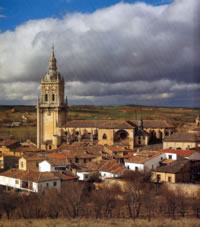
When Dominic was seven his education was put in charge of Jane’s brother, a priest, and when he was fourteen he entered the school at Palencia, one of the few higher schools in Spain at that time and soon to become a university, where he studied liberal arts and theology for ten years. He lived a rather bookish life but during a time of famine sold his books to assist the poor. In 1196, when he was about 24, he joined the cathedral chapter of Osma.
The canons of the Cathedral were priests associated with the bishop who had recently reformed their community life to live strictly in poverty according to the Rule of St. Augustine. The prior and reformer of this chapter was the remarkable Diego de Azevedo who in 1201 became bishop of the diocese. It was he who had noticed Dominic the student and obtained permission of the former bishop, Martin Bazan, for him to enter the chapter and in a few months to be ordained priest. Soon Dominic was appointed sacristan, then sub-prior, thus gaining useful experience in administration and the work of reform.
In 1203 when Alfonso VIII of Castile requested Bishop Diego to travel to Denmark to arrange the marriage of his son to a Danish princess, the bishop naturally chose the young priest to be his companion on the long, dangerous journey.
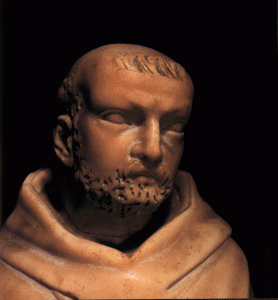
The journey proved the turning point in Dominic’s life, opening his eyes to a wider world and its problems. As they passed through southern France they encountered a shocking situation. While Dominic knew of the Moors and Jews in Spain, here he met former Christians who had become alienated from the Church and converted to the religion of the Cathari (Pure Ones), often called Albigensians from their stronghold at Albi.
This strange cult had its remote origins in the Gnosticism over which the Church had triumphed in the second century but had then passed through the Manichaeism of Persia to the Paulicians of Armenia, then in the ninth century to the Bogomils of Bulgaria, in the tenth to Constantinople, then in the twelfth with the Second Crusaders to northern Italy, France, and the Rhineland, and finally was achieving its greatest success among the nobility of southern France. There it took the form of a radical dualism according to which the visible creation was attributed to an evil god.
One night at an inn in Toulouse, Dominic engaged in a discussion about these doctrines with an innkeeper (who was probably a deacon of the Catharist church). Dominic was so moved by meeting this man deluded by the myth of two gods, one good but remote and hidden, and the other evil but creative, that, weary as he must have been after hours on horseback, he sat up all night talking with him and by dawn had won him back to the true God revealed in Jesus Christ.
3. Preaching in southern France
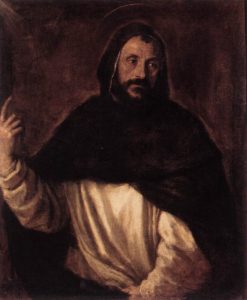
From Denmark, Diego and Dominic returned to Spain with news of their mission accomplished, only to be sent back two years later to fetch the princess, and then to find that she would not return. Their time in Scandanavia, however, taught them that to the east there were vast pagan territories waiting for the Gospel. Consequently, on their return journey they went first to Rome to beg the great Pope Innocent III to let them go on the missions together, but he refused, saying the bishop was needed back home. Diego, however, decided to return by way of the famous abbey at Citeaux in France and there received the Cistercian habit, probably in order to induce some of the monks to work in his diocese.
On the way back to Osma at the city of Montpellier in June 1206, Diego and Dominic met the Abbot of Citeaux and two of his monks who had been sent by Innocent to preach against Albigensianism. These three complained to Diego that they had no success in their preaching, chiefly because of the great reputation for holiness which the Perfect enjoyed among the people. Diego gave them a straight answer. They must not abandon their mission but must counter the Catholic clergy’s bad example, by preaching as the Apostles had done, barefoot and begging.
The Cistercians replied that they did not have the courage for this unless Diego would show them how — which he, with Dominic, proceeded to do.
For four years the band of preachers traveled about southern France preaching and holding public disputes with the Perfect. It was said that on one occasion the judges for one of the disputes threw the books in which Dominic and his opponents had written their briefs into a fire, and only Dominic’s survived the test. In 1207 the preachers were joined by no less than twelve other Cistercian abbots and they separated into smaller bands, and Diego and Dominic, along with a companion, William of Claret, centered their preaching on the town of Prouille. Here Dominic soon gathered a group of about twelve ladies converted from the cult who wished to continue their ascetic life as Catholic nuns, but needed protection from their families. In the same year Diego finally returned to Spain, probably with hopes of returning with new recruits, but died there December 30, 1207.
4. Foundation of the Order of Preachers
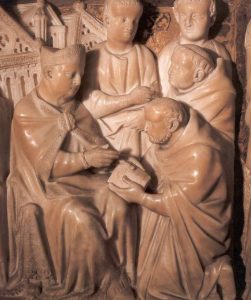
In these troubled times, even after the Cistercians had finally returned home, Dominic went on preaching. Sometimes he stayed at the convent in Prouille which in 1213 he rebuilt and where William Claret was his companion. But most of the time he was on the road.
At the canonization process at Toulouse three women, Guillelmine Martini, Noguera of Toulouse, and a nun of Saint Croix named Beceda, testified to having given him hospitality many times (probably during 1210-11) and observed his extreme poverty and rigor of life and his frequent exhaustion. He was often threatened with death and was reputed to have performed miracles and successful exorcisms.
Dominic had won the confidence of the local bishops (who were Cistercians) and during 1213 he was made vicar of Carcasonne and in 1214 parish priest of Fanjeaux. By this time he was beginning to see he needed a regular group of helpers and planned to locate them at Fanjeaux, but in 1215 he was called to Toulouse by the Cardinal Legate to preach. Here a certain Peter Seila invited Dominic and several companions Dominic had managed to gather one by one to live in his own house (still standing) which thus became “the cradle of the Order.”
In this same year, 1215, Dominic accompanied Bishop Fulk of Toulouse to the IV Lateran Council in Rome and with the help of Cardinal Ugolino (the future Gregory IX, who also sponsored St. Francis of Assisi), gained permission to found an Order of Preachers, provided they would conform to the decree of the Council against new orders by accepting one of the traditional rules.
Innocent III, one of the most far-sighted of the Popes, saw in Francis (to whose order he had given oral approval in 1209) and Dominic, whose fidelity to the Holy See he recognized, the solution to the problem of the itinerant preachers over which he had long pondered. Dominic himself seems finally in Rome to have seen (it is said by a vision of St. Peter and St. Paul he experienced in the Old St. Peter’s) the universal meaning of the Order for which he had so long served an apprenticeship.
5. Saint Dominic and his mission on the roads of Europe
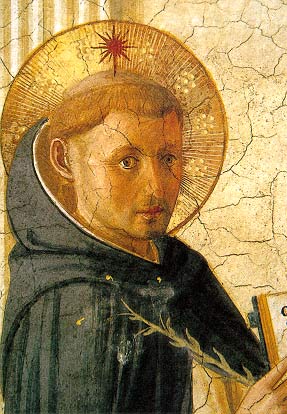
In returning to Toulouse he held a meeting of his companions who now numbered about 16 and announced to them (perhaps at Pentecost) an astonishing decision, which brought protests from the bishop and even from Simon de Montfort. Dominic had been warned in a vision that the Count would soon be killed and the work of preaching in the region stopped by civil war. Moreover, his new concept of the Order gained in Rome determined him to make a daring move — to disperse his brethren so recently formed into an Order, throughout Europe.
Dominic then set out on foot to Rome to obtain further papal privileges to make the work of the Order more effective and to overcome the opposition that had immediately appeared in Paris to the coming of the friars to the University. Successful in this, in 1218 he began a visitation of his dispersed men. Dominic the Little and Miguel de Ucero had already returned from Spain. Bertrand Garrigues and John of Navarre had come from Paris to report on the situation and Dominic then sent them to Bologna thus beginning a center at the second great university in Europe. Dominic, after visiting Bologna, and Prouille, went on to Spain where he set up a house of friars and another of nuns, and in Segovia, Palencia, and San Esteban de Gormaz more houses of friars. To the nuns of Madrid he wrote a short letter, the only writing, other than legal documents, which we have of his, urging them to a strict cloistered, contemplative life and protecting their control of their monastery. He had gathered a group of friars at Guadalajara but they quickly fell away, although through his prayers most returned.
From Spain he returned to Toulouse from which houses at Lyon, Montpellier, and Bayonne were soon to develop. Here he met Bertrand again and traveled with him to Paris, on the way somehow preaching to German pilgrims, although he did not know their language. In Paris under Matthew he found no fewer than thirty brethren, including Henry of Marburg, the first German friar, and Guerric, who was to found a house at Metz, Peter of Rheims, a future Provincial of France, Etienne de Bourbon, to be a famous preacher, and William of Monferrato, a theologian with whom Dominic two years before had discussed going on the missions. While Dominic encouraged study he also sent some of the brothers on missions from which new houses were soon to arise.
Dominic in August 1219 went to Bologna which would remain his home for the rest of his life. Here he found a large community including no less than four Masters from the University. This growth was due to Master Reginald, a teacher of canon law in Paris whom Dominic had previously met at Rome where Reginald had come on pilgrimage to the Holy Land. Reginald had later fallen sick, but in a vision was healed by the Virgin who showed him the habit of the Order which Dominic therefore adopted. Reginald had gone on to Jerusalem but then returned to Bologna where his preaching drew many vocations. Dominic immediately sent him back to Paris to deal with the difficulties in the university.
The community in Bologna had its troubles, including demonic incidents which, after Dominic’s death, led to the establishment of the Salve Regina procession. Several of the brethren got the idea they should become Cistercians but were dissuaded by Reginald and Roland of Cremona who was to become the Order’s first Master of Theology at Paris. Here Dominic also met a rich young lady, Diana d’Andalo who obtained a grant of land from her father for a monastery of nuns of the Order which she wished to enter in spite of much opposition from her family.
Dominic soon went to see the Pope at Viterbo for more letters of recommendation for his brethren now so widely scattered. The Pope sent him to Rome to reform a convent of nuns at San Sisto Vecchio in Rome and with the assistance of some nuns from Prouille he made this his third foundation of Dominican women. By this time his health was beginning to show signs of decline, worsened by grief over news of Reginald’s death in Paris, but the Pope made him head of a preaching mission composed of men from several religious orders.
Before starting this mission, Dominic had to return to Bologna for the First General Chapter of the Order with about thirty delegates, already including two from Scandinavia, which met on Pentecost 1220. Dominic first attempted to resign and was refused, but a system of four “definitors” was set up to assist him. At this Chapter it was established that the Rule and Constitutions were not to bind under sin and that all provisions were dispensable for the sake of the preaching mission. The Constitutions was written in two parts: the first covering liturgy and asceticism borrowed from the Premonstratensians but with appropriate modifications; the second, very original, covering the government of the Order. The supreme power of the General Chapter to legislate and the office of the Master of the Order were established. Strict mendicancy was adopted and immediately put into practice by giving up all revenue-producing properties. The studies at Paris were also regulated.
6. Death of saint Dominic in Bologna

Dominic then proceeded to the preaching mission of the Pope in Lombardy which was also a territory where the Waldensians (an evangelical sect) and Albigensians were powerful, but found the country involved in war and in preparation for a crusade to the Holy Land. His work was cut short by his third illness in a year, and in 1221 he returned to Rome to report to the Pope and to finish the work of establishing the nuns at San Sisto, a community which included Sisters Blanche, Constance, Nubia, Theodora, Thedrana, Nympha, Maximilla, and Sabina.
Dominic was also seeking assistance to found more houses throughout Italy and dealing with a problem of brethren deserting the Order. It was probably at this time that he met St. Francis of Assisi, who was also a friend of Cardinal Ugolino, the future Gregory IX, who had assisted in getting papal approval for both mendicant Orders. After Easter the friars took up residence at the wonderful fifth-century church of Santa Sabina, on the family property of Honorius III, where they built a cloistered convent in which the cell of Dominic is still preserved. In front of San Sisto, Dominic miraculously raised from death or near death a young man, Napoleon, hurt in a horse race.
In May 1221 Dominic returned to Bologna for the Second General Chapter of the Order which set up eight provinces: Spain, Provence, France, Lombardy, Rome, and probably Hungary, Teutonia, and England. This Chapter missioned Master Paul of Hungary, prior of Bologna and canonist who at the request of Dominic had compiled a Summa de Penitentia for the education of the brethren, along with Blessed Sadoc, to Hungary, Solomon of Aarhus with some German brothers to Denmark, Gilbert Ash with companions to England, and Jacek of Opole (St. Hyacinth) and his brother Ceslaus and Henry of Moravia to Poland. By the sixth Chapter there were added the “minor” provinces of Jerusalem, Greece, Poland and Dacia and so the twelve remained to the end of the century.
After the Chapter Dominic continued to travel and preach and had the joy of receiving Diana d’Andalo into the Order and founding her convent of St. Agnes in Bologna. On July 28 he again fell sick and was confined to bed on August 1. Because of the intense heat in the city the brethren moved him to the Benedictine priory of Monte-Mario. On August 6 he called Prior Ventura, confessed, spoke to the brethren, asked to die at home, and was carried to the convent of St. Nicholas, where he again promised the brethren he would intercede to God for them and then died on the evening of the August 6, not yet fifty years old. Jordan of Saxony was elected as his successor, and at the initiative of Gregory IX Dominic was soon canonized in 1234. At the moving of his body a very well attested miracle occurred in the sweet odor of sanctity which filled the entire church and lingered for days.
Besides Dominic’s predominant trait of compassion of which I have already written, what was his personality? He left us no writings, except the letter already mentioned to the nuns of Madrid and some letters of penance to heretics he had converted. Moreover, he seems to have been reticent to speak of his spiritual experiences. But his character is clearly manifest in the Constitutions which I will describe in more detail later and in testimonies of the witnesses at the process of canonization, as well as in the life by Jordan of Saxony, who, although he had not known Dominic long, carefully reported what he had heard from those who knew him well.
From these sources we gather that what was most evident to others was that Dominic’s compassion for people in their spiritual needs fired him with a consuming desire to preach. To his last days he was constantly on the road, often walking barefoot as much as 35 miles a day, taking the frequent hardships cheerfully, and ready to be martyred for the Gospel. We do not know what his preaching was like except that it moved his audience and himself to tears. Yet it was often rejected by the heretics. He constantly urged his brethren to share in this same mission, even sending out novices to preach, but at the same time very much concerned to have them educated and to encourage them to study that they might preach well. At the end of his life his vision had grown to lead others not of his Order to preach and to extend this to the missions of the pagan east. He wanted nothing to get in the way of this task and therefore tried to turn the administration of the Order over to lay brothers and to resign as Master, and he repeatedly refused offers of the episcopate.
The second mark of his life was his prayer. He was convinced that preaching without prayer would not be effective. An early work called the Nine Ways, which is supported by the other evidence, shows that he loved to pray with his whole body, kneeling, prostrating himself, holding up his hands in various gestures. He prayed on his journey, sang hymns, and at night, even after a long day’s journey spent hours in the church in prayer, and even slept there. He sang Mass frequently, often with tears, and he loved the Hours to be sung with spirit. His devotion to the Blessed Virgin established in the Order the tradition that eventually took a popular form in the holy rosary. He loved to keep silence and urged this on his brethren. Several witnesses repeated in the Acts of Canonization that “he spoke only of God or to God.” Yet it is also clear from these testimonies that he was always approachable, friendly, and ready to encourage and console.
The third mark was the penitential character of his life, which also was associated with preaching, since he believed it was necessary as a witness to the truth of the Gospel. In addition to the hardships of his traveling and its dangers, he was merciless on himself with regard to fasting (in Lent on bread and water), and even when sick never ate meat. He wore a hair shirt, a chain, and frequently used the discipline to blood when praying at night for those he hoped to convert. His confessor testified that he was a virgin, but he admitted on his death bed that he had perhaps been more pleased to talk to young women than to old. Then he regretted that in thus trying to warn his brethren of the need to guard chastity he had seemed to boast.
Linked to his asceticism was his insistence on poverty. He himself had begged from the beginning of his mission in France, but only gradually came to insist on it for his Order. He wanted the friars to be poor in clothing, housing, food, and even their churches and liturgical vestments. On these points of ascetic observance he was very strict, although gentle in his corrections, and ready to dispense, but only in view of the preaching mission or the actual weakness of the brethren. On his death bed he promised to be of more use to his brethren than in life, but left them as his legacy, “Cherish love, preserve humility, possess only the poverty you have freely chosen.”
After his death the early brethren understood very well that Dominic desired no cult of personality in his Order, since the real way to honor his memory was to carry on the “holy preaching.”
(Sources : Ashley, Benedict. The Dominicans. The Liturgical Press. 1990; Hinnebusch, W. The Dominicans. A Short History. Dominican Publications, 1985)

